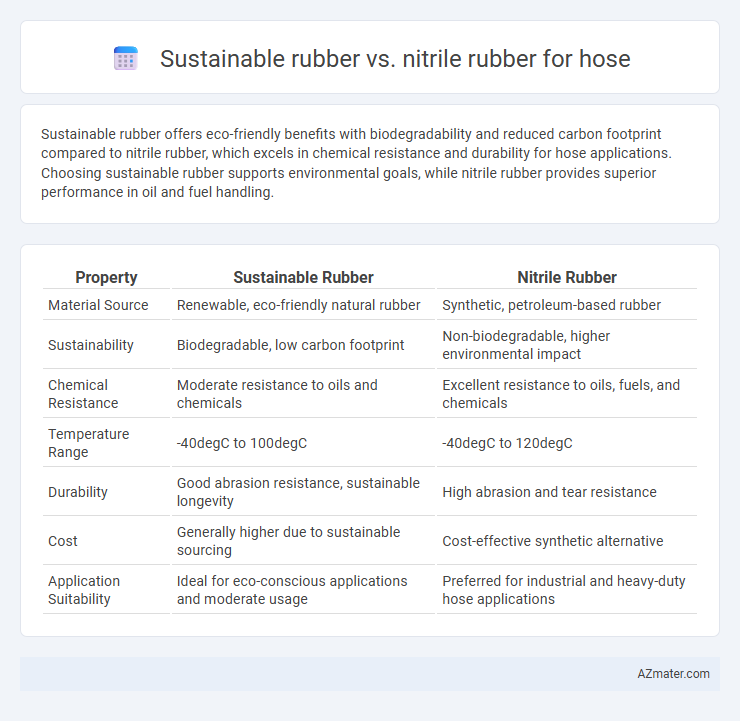Sustainable rubber offers eco-friendly benefits with biodegradability and reduced carbon footprint compared to nitrile rubber, which excels in chemical resistance and durability for hose applications. Choosing sustainable rubber supports environmental goals, while nitrile rubber provides superior performance in oil and fuel handling.
Table of Comparison
| Property | Sustainable Rubber | Nitrile Rubber |
|---|---|---|
| Material Source | Renewable, eco-friendly natural rubber | Synthetic, petroleum-based rubber |
| Sustainability | Biodegradable, low carbon footprint | Non-biodegradable, higher environmental impact |
| Chemical Resistance | Moderate resistance to oils and chemicals | Excellent resistance to oils, fuels, and chemicals |
| Temperature Range | -40degC to 100degC | -40degC to 120degC |
| Durability | Good abrasion resistance, sustainable longevity | High abrasion and tear resistance |
| Cost | Generally higher due to sustainable sourcing | Cost-effective synthetic alternative |
| Application Suitability | Ideal for eco-conscious applications and moderate usage | Preferred for industrial and heavy-duty hose applications |
Understanding Sustainable Rubber: Definition and Sources
Sustainable rubber is derived from renewable resources such as natural latex harvested from rubber trees (Hevea brasiliensis) through eco-friendly practices that minimize environmental impact and support biodiversity. This type of rubber emphasizes reduced carbon emissions and sustainable land use, contributing to a circular economy in the rubber industry. In contrast, nitrile rubber is a synthetic polymer produced from petroleum-based butadiene and acrylonitrile, lacking the renewable and biodegradable properties associated with sustainable rubber.
What is Nitrile Rubber? Key Properties and Applications
Nitrile rubber, also known as NBR or Buna-N, is a synthetic elastomer derived from acrylonitrile and butadiene, prized for its exceptional resistance to oils, fuels, and chemicals. Key properties include high tensile strength, excellent abrasion resistance, and superior performance in temperatures ranging from -40degC to 120degC, making it ideal for industrial hose applications. Common uses of nitrile rubber hoses encompass fuel lines, hydraulic systems, and pneumatic equipment where durability and chemical resilience are critical.
Environmental Impact: Sustainable Rubber vs Nitrile Rubber
Sustainable rubber, derived from renewable natural sources, significantly reduces carbon emissions and deforestation compared to synthetic nitrile rubber, which relies on petrochemical compounds. The biodegradability of sustainable rubber minimizes environmental pollution, whereas nitrile rubber's resistance to degradation contributes to long-term waste accumulation. Lifecycle assessments highlight sustainable rubber's lower ecological footprint, making it a preferred choice for eco-conscious hose manufacturing.
Performance Comparison: Durability and Flexibility
Sustainable rubber offers enhanced environmental benefits while maintaining competitive durability and flexibility compared to nitrile rubber, which is traditionally known for its excellent resistance to oils and abrasion. Sustainable rubber formulations often incorporate natural latex or bio-based additives that improve elasticity without compromising tensile strength, making them suitable for dynamic hose applications. Nitrile rubber still outperforms in extreme chemical resistance and temperature stability, but sustainable rubber alternatives are closing the gap with ongoing improvements in polymer technology.
Chemical Resistance: How Each Material Performs
Sustainable rubber, often derived from natural sources, offers moderate chemical resistance primarily against water, mild acids, and alkalis but tends to degrade when exposed to oils, fuels, and strong solvents. Nitrile rubber (NBR) excels in chemical resistance, especially against petroleum-based oils, fuels, lubricants, and many hydrocarbons, making it ideal for industrial hose applications involving aggressive chemicals. While sustainable rubber supports eco-friendly practices, nitrile rubber outperforms in longevity and durability in chemically harsh environments.
Cost Analysis: Sustainable Rubber vs Nitrile Rubber Hoses
Sustainable rubber hoses offer a competitive cost advantage over nitrile rubber hoses due to lower raw material expenses and reduced environmental compliance costs. Nitrile rubber hoses, while typically more expensive upfront, provide superior resistance to oils and chemicals, potentially lowering maintenance and replacement costs in harsh applications. Evaluating total cost of ownership, sustainable rubber hoses can be more economical in general use, whereas nitrile hoses justify higher costs where chemical durability is critical.
Lifecycle and Recycling Considerations
Sustainable rubber, often derived from natural latex or bio-based sources, offers a lower carbon footprint and enhanced biodegradability compared to synthetic nitrile rubber, which is petroleum-based and less eco-friendly. Lifecycle analysis reveals sustainable rubber hoses typically exhibit reduced environmental impact through renewable sourcing and easier end-of-life composting, while nitrile rubber hoses provide superior chemical resistance and durability but challenge recycling efforts due to complex polymer structures. Recycling sustainable rubber benefits from established natural rubber recovery processes, whereas nitrile rubber recycling often requires advanced mechanical or chemical methods, limiting circular economy potential and increasing disposal costs.
Industry Applications: Which Sectors Prefer Each Type
Sustainable rubber is extensively preferred in the automotive and food processing industries due to its eco-friendly properties and compliance with stringent environmental regulations. Nitrile rubber dominates sectors like oil and gas, petroleum, and chemical manufacturing because of its excellent resistance to oils, fuels, and harsh chemicals. Industrial hoses for pharmaceuticals often favor sustainable rubber for its non-toxic and biodegradable characteristics, while heavy-duty hydraulic systems rely on nitrile for durability under extreme conditions.
Certification and Regulatory Compliance
Sustainable rubber hoses often feature certifications such as FSC (Forest Stewardship Council) or ISO 14001, demonstrating adherence to environmental management standards and responsible sourcing practices. Nitrile rubber hoses comply with FDA and REACH regulations, ensuring safety and chemical resistance for industrial and food-grade applications. Both materials require adherence to regional standards like RoHS and EPA for environmental impact, but sustainable rubber emphasizes eco-friendly production and biodegradability.
Making the Right Choice: Factors to Consider for Hose Selection
When selecting hose materials, sustainable rubber offers eco-friendly benefits such as biodegradability and reduced carbon footprint, making it ideal for environmentally conscious applications. Nitrile rubber excels in chemical resistance, oil compatibility, and durability, which suits industrial environments requiring high-performance hoses. Factors like application temperature, fluid type, environmental impact, and cost-effectiveness should guide the choice between sustainable rubber and nitrile rubber for hoses.

Infographic: Sustainable rubber vs Nitrile rubber for Hose
 azmater.com
azmater.com